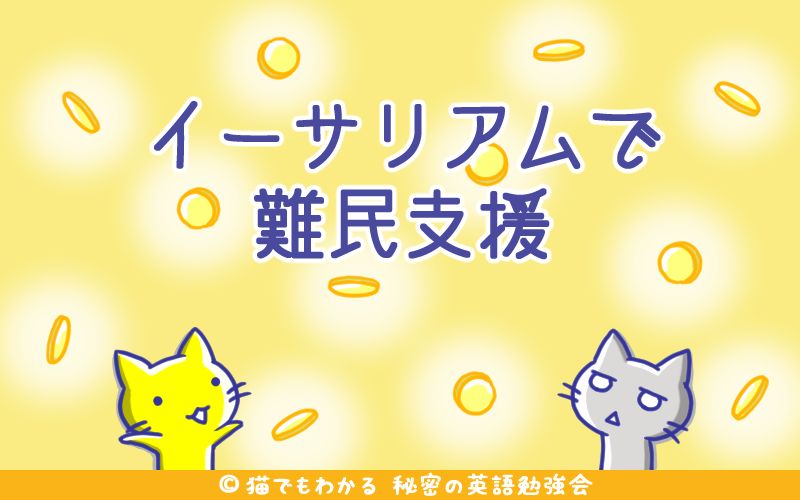
どうもワイです。
国際連合世界食糧計画 (WFP) が難民支援のためにイーサリアムのブロックチェーン技術を使用しています。これまでは銀行経由で送金や管理が行われていましたが、ブロックチェーン技術を使うことで手数料などが削減でき、節約した分だけさらに多くの人の支援ができるようになったそうです。
仮想通貨の英語記事シリーズ、今回はこの記事を読んでいきます。
WFP’s Ethereum Project Successfully Serves 100,000 Refugees, Now Aims Even Further
※ かなり削りましたがそれでも今回は結構長いです。
銀行手数料を大幅カット
WFP being the most extensive humanitarian aid organization provides assistance to over 80 million people spread across 80 countries throughout the world. Until now, the organization strives to provide food and necessary facilities through cash-based transfers processed via banks, which the aid recipients could use to purchase food.
世界最大の人道支援機関である国際連合世界食糧計画 (以下 WFP) は、世界 80 ヵ国の 8000 万人以上の人々を支援しています。現在までに、WFP は銀行を通して現金によって食料や必要な施設の支援を行ってきました。被援助者は食料などの購入にこの支援金を使用していました。
In 2016, WFP initiated an Innovation Accelerator which allowed the organization to adopt innovations efficiently. The ‘Building Blocks’ project, as an offspring of Innovation Accelerator, employs distributed ledger technology for cheaper, secure and faster transactions. The WFP realized the expensive, time-consuming and multi-layered existing banking ecosystem, and sought blockchain technology to provide an alternative. In 2016, the humanitarian organization made use of ‘Parity Ethereum’ to establish a private and secure blockchain for its experimental phase.
2016 年、WFP は「Innovation Accelerator」を開始し、効率的にイノベーションを取り入れることができました。「Innovation Accelerator」から生まれた「Building Blocks」プロジェクトでは、より安く安全かつ高速なトランザクションのために、分散台帳技術が採用されました。WFP は、既存の銀行は費用がかさみ、時間効率が悪く、多層化されていることに気付き、ブロックチェーン技術にその代替としての機能を求めました。2016 年、WFP は実験段階として「Parity Ethereum」を使用したプライベートかつ安全なブロックチェーンを開発しました。
The use of Ethereum allows WFP to monitor the transactions continuously and have direct control over the aid cycle. Instead of the bank, WFP communicates directly with the local retailer to settle the dues of the beneficiaries. The blockchain-based aid program also eliminates banking commissions, therefore the money saved could help others in need.
イーサリアムを使用することで、WFP は継続的にトランザクションを監視し、支援サイクルを直接的にコントロールすることが可能になりました。銀行の代わりに WFP が各地の小売店と直接連絡を取って支援金を決定します。また、このブロックチェーンベースの支援プログラムにより銀行手数料が不要になるため、節約した資金を他の被援助者へ充てることができます。
In May 2017, using the blockchain pilot project, WFP successfully assisted nearly 10,000 refugees in Jordan. At the time, Bernhard Kowatsch, Munich WFP innovation Lab Chief reported that the project is believed to have saved them nearly $150,000 of upfront payments by eliminating 98 percent of banking transaction fees.
2017 年 5 月、ブロックチェーンのパイロットプロジェクトを使用して、WFP はヨルダンの難民約 1 万人を支援することができました。ミュンヘンの WFP イノベーションラボチーフの Bernhard Kowatsch 氏は、同プロジェクトにより銀行送金手数料の 98 パーセントを削減することで、前払金の約 15 万ドルを節約できたと報告しました。
The initial success of the Building Blocks project, where 100,000 refugees have benefited, have led the WFP along with Parity technologies to set the goal further and help 500,000 refugees by the end of 2018.
10 万人の難民に支援した「Building Blocks」プロジェクトの最初の成功に続き、WFP は Parity テクノロジーにより 2018 年中に 50 万人の難民を支援することを目標としています。




